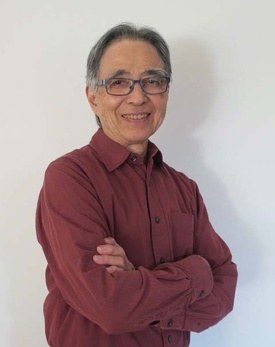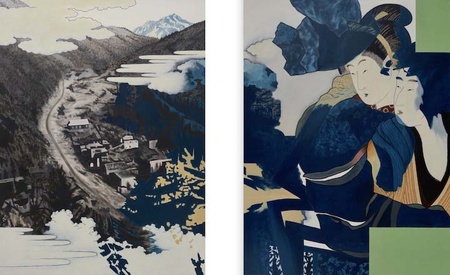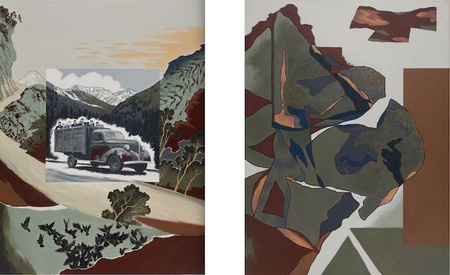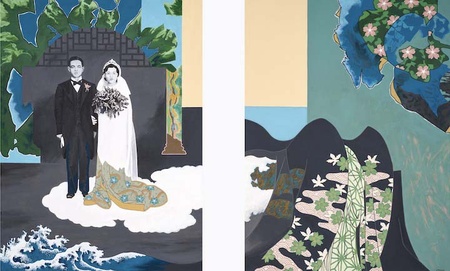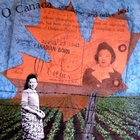“Ever since we both attended the Vancouver School of Art back in the 1950s, I have always respected Norman. He is a creative, seriously dedicated, focused, hard-working and disciplined artist. His work, with many references to two cultures, is constantly changing and growing. It is wonderful that we are both still painting and showing our work in our mid-80s…. We were so young!”
—Artist Tsuneko Kokubo (Silverton, BC) whose own Of Light Itself: RetroPERSPECTIVE is now showing at the Langham Gallery, Kaslo, BC
Sansei Ottawa artist Norman Kiyomitsu Takeuchi speaks about the complexities of being Japanese Canadian today through the remarkable range and vision expressed through his art. His art is progressive with deep insight and compelling expression that demands our attention, and enables us to reflect on the ongoing trauma of internment that still affects the Japanese Canadian community.
At the time of putting together this interview, Takeuchi is busy preparing for the launch of his latest show, Long Division, at Ottawa’s Karsh-Masson Gallery, curated by Emily Putnam.
This is the latest in a rapid succession of shows, most recently beginning in 2019 with the showing of his painting, “Interior Revisited,” in a group show at Toronto’s Royal Ontario Museum (Being Japanese Canadian: Reflections On A Broken World) and Sites of Memory: Legacies of the Japanese Canadian Internment (2019) at Carleton University. He quickly followed those up with Equal Time (2020), Scrolling (2022), and now Long Division at the Karsh-Masson Gallery in Ottawa, which runs from September 8 to November 4, 2022.
“It was only when I became a full-time artist in 1996 that I was able to devote all my time to making art. I guess I’m a workaholic,” he answers to my astonishment at his impressive productivity. “I put almost all of my energies into my work while I was a designer and I did the same when I became an artist. Throughout my whole art career I’ve worked steadily with each stage blending into the next and I just carried on no matter what. I probably produced more or less the same amount of work each year.”
Long Division is a meditation about the past e.g., being evacuated in 1942, forced to live in exile, then forced to move ‘East of the Rockies’ after 1945 and a prayer of sorts for a better future.
* * * * *
To start off with, you’ve been remarkably prolific over these past few years and your works have been looking at the World War Two Japanese Canadian (JC) internment experience in expansive, very personal new ways. What is it about your own history that you want to say to your viewing audience?
I would say my story is only one of many and that despite many hardships, the Issei (first generation immigrants) and Nisei (second generation immigrants), through resilience and determination, rebuilt their lives to become solid citizens of Canada, the country they always belonged to. I’m hoping the work will raise questions in people’s minds about what had happened.
Is there a particular message to the JC viewer? What about the non-JC viewer?
My artwork is a very personal statement about being Japanese Canadian, but I’m hoping JCs who look at it will find something they can relate to and feel some kinship with what I’m doing. As for the non-JCs, it would be great if their eyes were opened to a dark, shameful episode in Canadian history that they didn’t know about.
In a recent piece that I’ve written, it is apparent to me that there are generational gaps of knowledge about the place of “the internment” in our collective JC history that are growing. Are you worried in any way that the importance of that time in history will be lost to the JC community?
Yes, it does worry me but at the same time, I’m heartened by the accounts I’ve read about the yonsei and gosei who are interested enough in the JC history to keep it alive. I guess though it’s normal that the generational gaps are getting wider, which is why inclusion of the JC history in the education system and the history books become so important.
What has been the effect of the “dislocations” (e.g., internment, post WW2 relocation west of the Rockies and Japan) that JCs have experienced?
I don’t know if I can answer that. I can only give you an impression of what I’ve formed based on what I’ve read in the Bulletin and the Nikkei Voice. Based on how often the topic of the internment comes up in every issue, it’s obvious that the internment experience has had an enormous impact on the JC psyche and has become a touchstone for who we are.
So, why the title Long Division?
The title refers to the discrimination and racism the Japanese people experienced in Canada, especially in BC, before, during and after WWII, creating a division between the Japanese and the white population. On another level, the title is a reference to the fact that racism continues in different parts of the world, including Canada, and shows no signs of going away.
What kinds of ‘divisions’ in the world concern you?
Any kind of division that is the result of blind hatred is very concerning.
What’s been divided?
People are divided. People are divided on race, gender, religion, politics, all the differences that, in a more tolerant, accepting world, would be an interesting and vibrant place to live in.
The idea of using the diptych is interesting. Why did you choose that method to present your ideas?
I wanted to take a different approach to the theme of being Japanese Canadian, a theme I’ve been pursuing for the past several years. The plan was to use the diptych format with the left canvas depicting some historical event and the right canvas representing, through abstraction, feelings of displacement, confusion, loss of identity, anger. Instead of joining the two canvases in the traditional way, I made the decision to create a gap between the two, a division so to speak, to emphasize the racial divide between the Japanese and the non-Japanese in BC that resulted in the forced uprooting.
Did the 80th anniversary of the beginning of the internment factor into the timing of this exhibition? Is there something about the 1942 internment that you wanted to say to the 2022 JC community?
No, the 80th anniversary had no bearing on the timing. I was unaware of the upcoming anniversary when I submitted a proposal for this exhibition to the City of Ottawa, ultimately accepted, in 2020.
What lies at the basis of my work is the feeling of astonishment and respect that I now have for the way the people of my parents’ generation were able to persevere under extreme difficulties and were able to overcome and rebuild. I can’t help wondering how I would have coped if I was in their place.
Your use of figurative and abstract images is intriguing. Was there a reason why you chose figurative for the past and abstract for the future? What lies in the space in between those images?
The most effective way for me to reference the past in my paintings was to use historical images, and it made sense to have the past on the left. The abstraction on the right was meant to amplify the historical events with the more intangible feelings of displacement, confusion, loss of identity, anger, as I said before.
The space between represents misunderstanding and intolerance leading to hatred that existed then and exists still. Even though the space separates the two canvases, both canvases with theircontrasting images are composed in such a way that they are visually linked just as weas human beings are all connected to each other, whether we like it or not.
How did you choose the locations of the paintings which were all important ones in Japanese Canadian history? What is their personal importance to you?
The choice of the locations was often determined by iconic images that struck me as having potential for creating a strong, compelling painting. Some of the images appealed to me for their historical importance (Immigrant, Hastings Park, New Comers) while others are personal (Wedding Song, Devine, Westwold, Kitsilano). The last three are places where we lived.
You seem to draw such strength and inspiration from traditional Japanese culture. Has it always been so?
No. In my younger years I did not want to be Japanese. This denial of sorts continued well into my early years as an artist and was reflected in my work. In other words, there was no reference to my Japanese heritage. I was determined to be a Canadian artist until, with some relief and—I have to say—feelings of being released, I became a Japanese Canadian artist. My work changed completely.
Where does the work from this show stand in your overall lifetime body of work? Can you comment about how you continue to develop as an artist?
Although it’s hard to say at this point, I think Long Division may be my most satisfying work to date, not only artistically but also emotionally. Somewhere in the process of making these paintings, my approach seemed to have changed from ambivalence to acceptance...and I believe you can see that when you look at the work in its entirety. A sign of maturity finally? Maybe.
In any case, moving on from Long Division, my latest work has become a return to exploring the world of abstraction. If the Japanese images are leaving and I’m returning to a more universal approach to art-making, it’s probably because I’m now in a more comfortable place and have accepted being who I am. This has to be good!
The values that you are addressing here are grand ones. Can you please talk a bit about how the values of love, resilience, hope, healing, connection and memory can be bridges to span the gaps that divide us?
As much as I would like to be more positive, I can’t divorce myself from the fact that to be human is to feel not only love but also hate...and because of that, there will always be division of one kind or another. All we can do is look to the values you listed in your question and hope for the best.
Ultimately then, what is the answer to this Long Division ‘problem’?
I’m out of my depth here so, if there is an answer to this problem, I don’t know what it is. Thankfully, there are people, and I know many, who are decent, generous and open-minded and who remind us there is also love in the world.
* * * * *
Norman Takeuchi - Long Division (Division longue)
At KARSH-MASSON GALLERY
September 8 to November 4, 2022
The opening will be on September 8, 2022 from 5:30pm. RSVP via Eventbrite.
*Instagram by @publicartottawa
*Galerie Karsh-Masson Gallery (Facebook)
© 2022 Norm Masaji Ibuki


